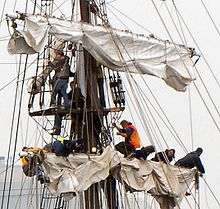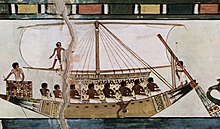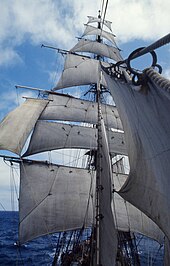Square sail


The square sail is a mostly rectangular or trapezoidal sail that is guided on a log called a yard. It is used to propel sailing ships.
At the lower end of the Rahsegels are pods attached and when lower sail (d. E. The lowest square sail on the mast, directly above the deck) and the necks (jibe) with which the Luv -Seitenliek is enforced.
development
The advantage of the square sail is that it can be driven across the keel line on several masts one behind the other on a ship and can also be placed several times on top of each other on each mast between yards. The maximum achieved with a total of 30 square sails in six floors is the five - masted full -rigged ship Prussia (1902–1910) built by the F. Laeisz shipping company . The area of the individual sail therefore remains easy to handle using individual sheets.
The main disadvantage of square sails is that they cannot be sailed as close to the wind as with sloping sails . A modern Bermudarigg can a course of up to 30 degrees up at about 0 degrees drift rest, a classic Schratrigg a course of 45 to 50 degrees with a drift of about 5 degrees and a Rahrigg can point of sail of about 60 degrees with 10- Reach 15 degrees of drift.
A dynamic disadvantage of the square sail is the high effort involved in setting and reefing . Therefore square sails are no longer used on modern sailing yachts. For reasons of authenticity, modern replicas of large sailing ships use square sails, for example the Royal Clipper , in an ultra-modern form. Their square sails can be rolled up in the yards (hollow racks) from the deck, which considerably shortens the time-consuming and personnel-consuming reduction of the sail area (reefing, recovery, mooring), makes it safe and eliminates the associated disadvantage. Square sailors (apart from the square ships of antiquity, the Viking boats and early medieval sailors such as Kogge, Nao) also have a number of sling sails , which improves the sailing properties enormously: the mizzen sail (as a gaff sail on full ships also on the mizzen mast , on barges on their own mizzen mast - mostly as a gaff sail with topsail, rarely as a triangular sail - and on brigs on the main mast ) as well as the staysail between the masts and as a headsail. Improvements such as brass winches and auxiliary motors for heating yards improved their handling considerably and relieved the crew. With mixed types such as schooner barges (first mast rigged, the others scraper rigged), jackass barque (front masts rigged, aft screech rigged, with three- / five-masters both types of rigging on the middle mast), polka rigs (three-masted schooner with two frame tops) one tried to find an optimal compromise between To find square and Schrat / gaff sails. However, it was also shown that a pure gaff rigging, especially with extremely large schooners (see: Thomas W. Lawson ), did not produce good sailing characteristics, since the sail area is difficult to handle with very large, highly rigged schooners due to the small number of very large sails; Frame-rigged ships have dynamic advantages because of the larger number of individual smaller square sails at different heights - especially in storms. In historical ocean freight traffic, yard ships were the preferred faster and safer type of ship ( clippers , windjammers ). In contrast, a number of large schooners drove along the east coast of the USA, including many up to four-masted schooners in the Baltic Sea. The largest sailing shipping companies such as Antoine-Dominique Bordes & Fils, F. Laeisz and (Rederi A / B) Gustaf Erikson had mostly or without exception square sailors.
The use of square sails on modern ships goes back to the northern European line of development in shipbuilding. The long boats of the Vikings used a single square sail, as did the cogs of the Hanseatic League . Square sails were used very early on by the Egyptians and Phoenicians , as can be seen on old pictures of ships. In the Mediterranean, however, the latin sail caught on, there the square sail only came into use again when the northern European and Mediterranean lines of development in shipbuilding merged from the 13th century. The large freighters of the 19th and 20th centuries were mainly square ships, especially in Europe, but also in the USA (tall ships from the shipping company Arthur Sewall & Co.). There were 7 five-mast ships, about 440 four-mast ships (10% full ships, 90% barges) and more than 1,500 three-mast ships (barges and full ships). In contrast, there was a seven-masted schooner (1902), about 16 six-masted schooners (2,800–3,700 GRT, since 1900, the size of large four-masted ships), about 150 five-masted schooners (870–3,200 BRT, since 1888, large three- and medium-sized to large four-masted ships) and about 300 four-masted schooners (since 1864, the size of large three-masted ships).
Naming of different square sails
Square sails are named after the mast and their position on it. The lowest sail (lower sail) on each mast bears the name of the mast (foresail, mainsail, cross sail (bagien)). The names of the other sails are, from top to bottom:
- Moon sails (English moonsail or moonraker ; extremely rare)
- Skysail ("sky sail "; English skysail )
- Royal sail (engl. Royal sail or royal )
- Bramsegel (engl. Topgallant sail )
- Topsail (Engl. Topsail )
- Under sail (Engl. Course sail )
The topsails and sometimes also the slab sails were divided into lower and upper to make handling easier. The European windjammers of the late 19th and early 20th centuries mostly drove split Mars and Bramsail plus royal sails (standard rig), rarely sky sails like the five-masted auxiliary barque Maria Rickmers on the first three masts (the only five-masted with sky sails) and the four-masted full ship Peter Rickmers on all four masts, the only ship of this type ever built with seven yards on all four masts. It was also the only four-masted full ship ever built for a German shipping company .
In many square sailors, the Obermars- and Oberbramrah as well as the yards above are slidably mounted on the mast and are lowered when not in use. The upper marsrah and the upper brahmrah come very close to the associated lower frame. With the upper sails recovered, this shifts the ship's center of gravity significantly in the direction of the ship's hull and improves its behavior in a storm (see picture). The yards are raised (fetched) when setting the sails, lowered (lowered) when recovering.
With Mars and Bram divided, up to eight square sails were possible on top of each other; However, ships with this rig (rigging) were extremely rare. Some clippers drove moon sails that played no role in terms of propulsion, but mostly had simple slab sails, so that even seven sails on the mast were only more common during the clipper era. Some clippers were able to lengthen certain yards with lee sail spars that could be moved outwards and attach lee sails there in order to better exploit weak winds. American square ships preferred six yards on the mast with simple bram and split topsails, plus royals and sky sails ("three-skysail yarders").
See also
Individual evidence
- ↑ Max Vinner: Boats of the Vikingshipmuseum. Vikingeskibmuseet, Roskilde 2013, ISBN 9788785180636 .



